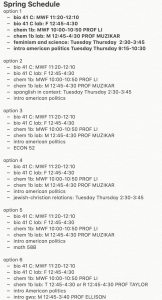By Nelia Perry ‘24
About a week before fall registration, I decided to make a table outlining all of the classes I intended to take for the next four years. That’s eight semesters, four classes each, for a total of 32 classes. At first, that seems like a lot. It’s plenty of room to explore different subjects and take classes outside of your major. But, in the process of planning my next four years––at least thinking I was planning for them, now discovering everything changes––I realized how few classes that truly is.
 Looking at the course catalog with 2,000-plus class that change each semester, I felt lost in the sea of options. How would I satisfy my desire to fill pre-med requirements, explore creative writing, take up new music skills, learn multiple new languages, and figure out what I wanted to do post-graduation in only 32 classes?
Looking at the course catalog with 2,000-plus class that change each semester, I felt lost in the sea of options. How would I satisfy my desire to fill pre-med requirements, explore creative writing, take up new music skills, learn multiple new languages, and figure out what I wanted to do post-graduation in only 32 classes?
Realizing that registration can most certainly be a stressful process, I wanted to share five major pieces of advice on what I have learned through two registration sessions: I know, a seasoned pro! I still have so much to learn, so much to explore, and so many perms* to write. But I thought I could shed some light on what I have learned so far.
- Do think about the major.
Liberal arts colleges like to emphasize that “it’s not about the major.” And while it is true that you can become a doctor as an art major or a filmmaker as a chemistry major, there are some advantages to planning ahead for your potential major, even in your first semester. Now, that doesn’t mean you are determining the course of your career based on your first-semester classes–there is still plenty of time for that–but your first classes do influence your trajectory moving forward.
For example, it’s important to pay attention to when introductory classes are offered. Take Intro to General Chemistry, a two-semester long classes that requires you take Chem 1A before 1B. However, Chem 1A is only offered in the fall and 1B only in the spring. Thus, if you decide you want to study chemistry or pre-med in the spring of your first year, you will have to wait another semester before you can get started with Chem 1A in the fall of sophomore year. I want to emphasize that there is no problem in waiting. There are sophomores and juniors in Chem 1A, as well as the first years who decide to take it right from the start, but this sequence issue is important to keep in mind. Moreover, most, if not all majors, will require upper division classes that have prerequisites. You will want to start chipping away at those prerequisites as soon as possible. My approach: take at least one class in your first semester that will count towards your potential major(s).
- Do think about graduation requirements.
While Pomona has a pretty open curriculum, there are some general education requirements. These include six different area requirements and three overlays. If you are unsure of what you want to major in and want to try out classes in a few different departments in your first semester, planning around these graduation requirements is a great place to start! In fact, I learned that many students focus solely on these area requirements when picking first-year classes. This lets you explore majors and fulfill graduation requirements simultaneously. My approach: cover at least two area requirements in your first semester. That might sound daunting, but this just means taking at least two courses in different departments. For example, Intro to Genetics (fulfills the area 4 requirement of a physical or biological science class) and Principles of Macroeconomics (fulfills the are 2 requirement of a social institutions and human behavior class). This is also a great way to meet lots of different people, form connections with professors with very different forms of feedback, and give you a variety of types of assignments (like balancing heavy reading classes with computational or lab-based ones).
- *Don’t be afraid of perming into a class.
At Pomona, “perming” refers to requesting the “permission to enroll” into a class from the professor. Some classes require all students to perm into them, while others will require a perm if the class fills up by your registration time. I found the experience of writing my first perm to be extremely daunting. They are only 250 characters long but need to convey a lot! However, you don’t lose anything by trying. My first semester I got really lucky and didn’t need to perm any of my classes. But my last registration period was a different story. I wrote three different perms for four classes. But guess what? It all worked out! I am super happy about the classes I am taking and how my schedule fits together. Professors are really flexible about accepting perms or reaching out to help suggest another section or similar class to take if they are unable to accommodate you. My approach: try to perm into at least one class in your first year to help prepare you for future perms and help you get over the fear of writing them. Additionally, reach out to more experienced students (your sponsors are a great option) for advice on how to write a perm.
- Do make back-up schedules and have them written out in detail before your registration time.
 In the fall I only outlined one potential schedule. I got lucky with a decent registration time and with classes that had plenty of space. However, upon reflection, I realized how stressed I would have been had that one schedule I’d outlined not been available when registering. As a result, I went a little overboard in the spring: I wrote out six different possible schedules.
In the fall I only outlined one potential schedule. I got lucky with a decent registration time and with classes that had plenty of space. However, upon reflection, I realized how stressed I would have been had that one schedule I’d outlined not been available when registering. As a result, I went a little overboard in the spring: I wrote out six different possible schedules.
Sitting down for my registration period, I felt like I chef following a VERY detailed recipe. I knew all the ingredients, had a detailed plan of the order in which to add those ingredients, and back-up plans in case I over-kneaded my bread dough or burned my caramel. While the process wasn’t totally smooth, having back-up plans helped me feel more at ease when a section I wanted wasn’t available or I had to wait for a perm to be accepted. My approach: while having as detailed a plan as I did might have been overkill, I recommend having at least a plan B and maybe a plan C in case your ideal schedule isn’t possible.
- Don’t stress it too much!
I know, I just outlined four reasons to feel stressed about registration, so isn’t it contradictory to advise you not to stress it? Well, not really. There are reasons to feel concerned that you won’t be able to enroll in the classes you wanted at first, learn from the professor your sponsors raved about, or arrange a schedule that allows you to sleep in until noon, but from my experience and the experiences of those who I have talked to, it all works out in the end.
I’ve heard great stories of someone who took a history class just because it was the only class left that seemed somewhat decent to them, and then ended up declaring history as their major. Or someone who didn’t get their first-choice professor but ended up forming a great connection with the professor they did have who has now written all of their letters of recommendation and serves as their biggest mentor. Sometimes luck and chance are better predictors of success than careful planning. And if you don’t have an experience like that, there are plenty more semesters to explore plenty more classes in the future. My approach: set off on your registration journey with both openness and preparedness. Being flexible and willing to take a class you brushed past at first, while simultaneously going into registration prepared with back-up plans and a perm template, will set you up perfectly for registration in your first two semesters at Pomona.
